Depression: Statistics, Challenges, and Treatment in Australia
VerifiedAdded on 2022/09/26
|6
|1551
|39
Essay
AI Summary
This essay delves into the multifaceted issue of depression, exploring its prevalence, causes, and treatment options, with a specific focus on the Australian context. It highlights the impact of depression on individuals, particularly adolescents, and discusses the challenges faced by various communities, including those from diverse cultural and linguistic backgrounds, and rural populations. The essay examines the increasing rates of depression, the role of environmental and social factors, and the importance of early intervention and support. It also touches upon the role of self-assessment, family support, and the need for effective treatments like antidepressants and psychoeducation. The analysis draws on various research studies and emphasizes the significance of addressing depression to prevent adverse outcomes such as suicidal thoughts and premature deaths. Furthermore, the essay underscores the importance of mental health awareness and the need for equitable distribution of resources to combat this growing mental health concern.
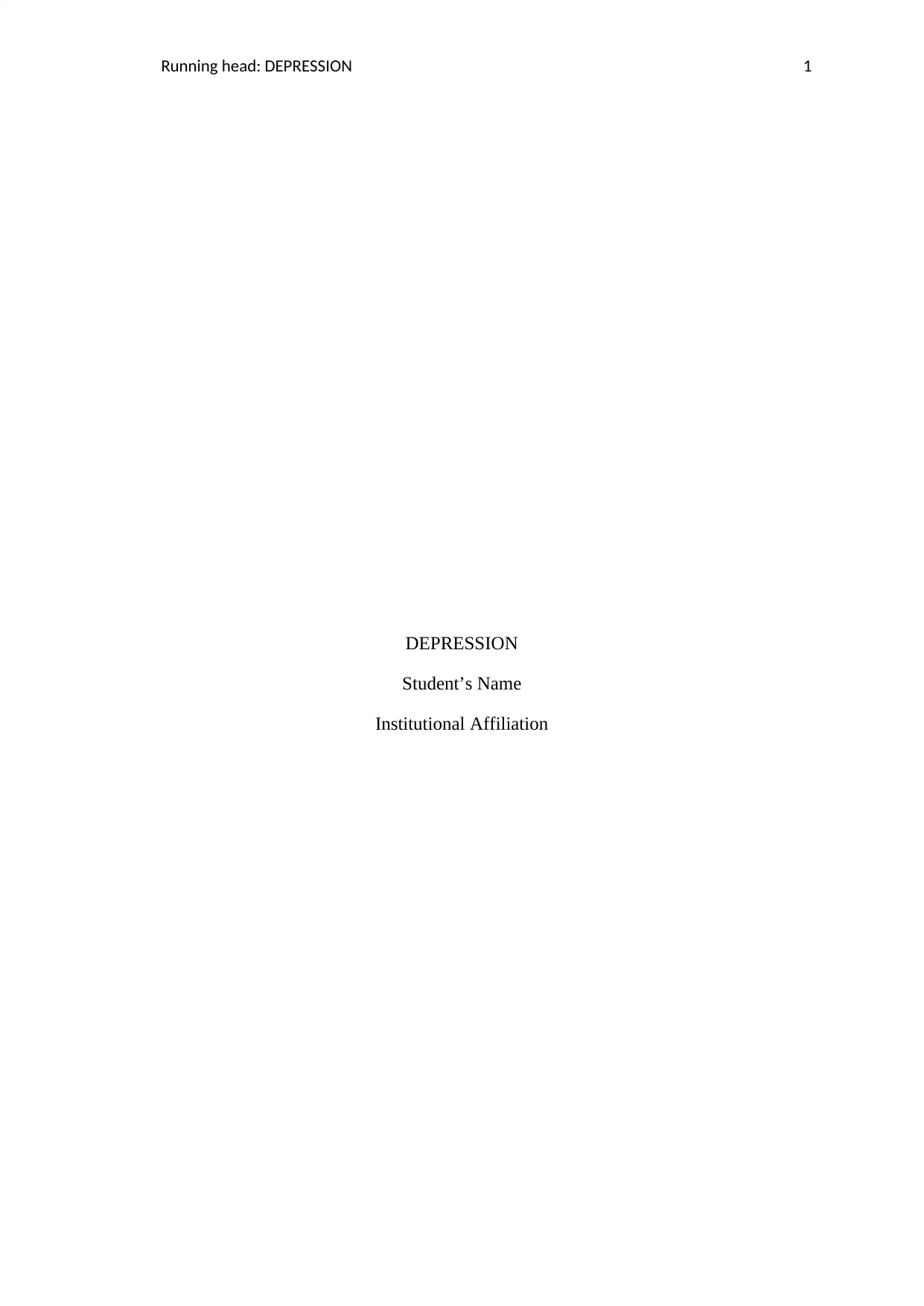
Running head: DEPRESSION 1
DEPRESSION
Student’s Name
Institutional Affiliation
DEPRESSION
Student’s Name
Institutional Affiliation
Paraphrase This Document
Need a fresh take? Get an instant paraphrase of this document with our AI Paraphraser
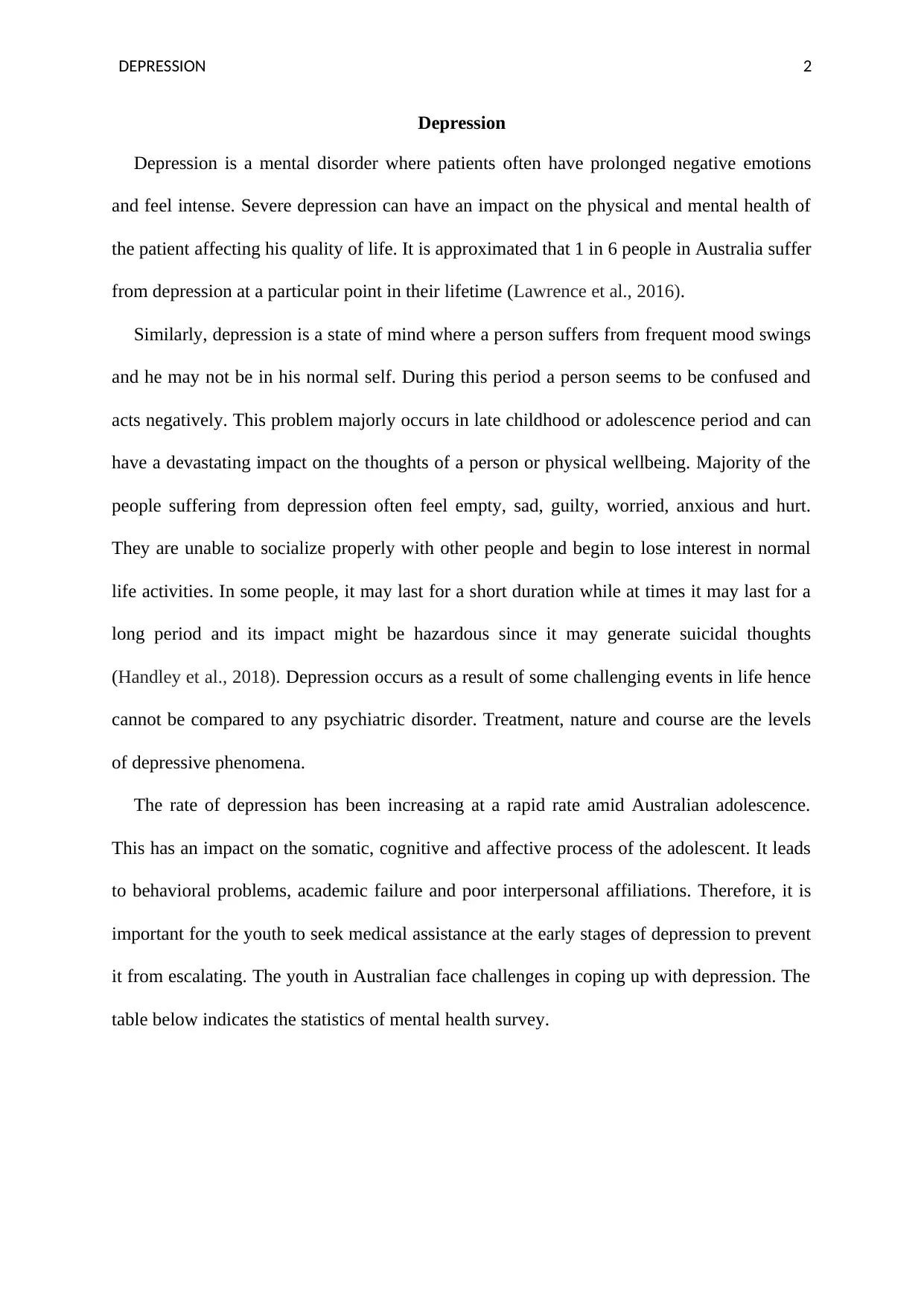
DEPRESSION 2
Depression
Depression is a mental disorder where patients often have prolonged negative emotions
and feel intense. Severe depression can have an impact on the physical and mental health of
the patient affecting his quality of life. It is approximated that 1 in 6 people in Australia suffer
from depression at a particular point in their lifetime (Lawrence et al., 2016).
Similarly, depression is a state of mind where a person suffers from frequent mood swings
and he may not be in his normal self. During this period a person seems to be confused and
acts negatively. This problem majorly occurs in late childhood or adolescence period and can
have a devastating impact on the thoughts of a person or physical wellbeing. Majority of the
people suffering from depression often feel empty, sad, guilty, worried, anxious and hurt.
They are unable to socialize properly with other people and begin to lose interest in normal
life activities. In some people, it may last for a short duration while at times it may last for a
long period and its impact might be hazardous since it may generate suicidal thoughts
(Handley et al., 2018). Depression occurs as a result of some challenging events in life hence
cannot be compared to any psychiatric disorder. Treatment, nature and course are the levels
of depressive phenomena.
The rate of depression has been increasing at a rapid rate amid Australian adolescence.
This has an impact on the somatic, cognitive and affective process of the adolescent. It leads
to behavioral problems, academic failure and poor interpersonal affiliations. Therefore, it is
important for the youth to seek medical assistance at the early stages of depression to prevent
it from escalating. The youth in Australian face challenges in coping up with depression. The
table below indicates the statistics of mental health survey.
Depression
Depression is a mental disorder where patients often have prolonged negative emotions
and feel intense. Severe depression can have an impact on the physical and mental health of
the patient affecting his quality of life. It is approximated that 1 in 6 people in Australia suffer
from depression at a particular point in their lifetime (Lawrence et al., 2016).
Similarly, depression is a state of mind where a person suffers from frequent mood swings
and he may not be in his normal self. During this period a person seems to be confused and
acts negatively. This problem majorly occurs in late childhood or adolescence period and can
have a devastating impact on the thoughts of a person or physical wellbeing. Majority of the
people suffering from depression often feel empty, sad, guilty, worried, anxious and hurt.
They are unable to socialize properly with other people and begin to lose interest in normal
life activities. In some people, it may last for a short duration while at times it may last for a
long period and its impact might be hazardous since it may generate suicidal thoughts
(Handley et al., 2018). Depression occurs as a result of some challenging events in life hence
cannot be compared to any psychiatric disorder. Treatment, nature and course are the levels
of depressive phenomena.
The rate of depression has been increasing at a rapid rate amid Australian adolescence.
This has an impact on the somatic, cognitive and affective process of the adolescent. It leads
to behavioral problems, academic failure and poor interpersonal affiliations. Therefore, it is
important for the youth to seek medical assistance at the early stages of depression to prevent
it from escalating. The youth in Australian face challenges in coping up with depression. The
table below indicates the statistics of mental health survey.
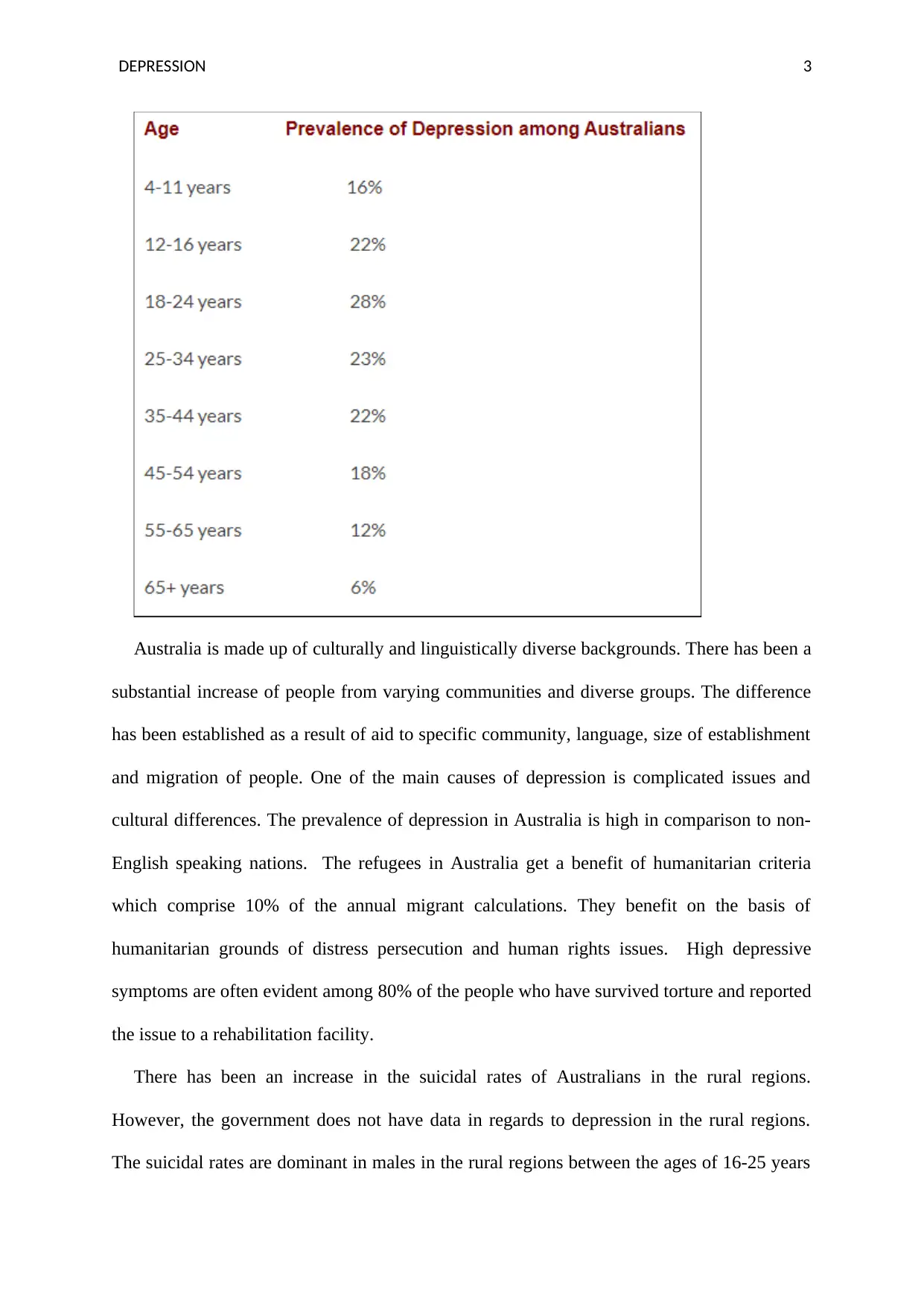
DEPRESSION 3
Australia is made up of culturally and linguistically diverse backgrounds. There has been a
substantial increase of people from varying communities and diverse groups. The difference
has been established as a result of aid to specific community, language, size of establishment
and migration of people. One of the main causes of depression is complicated issues and
cultural differences. The prevalence of depression in Australia is high in comparison to non-
English speaking nations. The refugees in Australia get a benefit of humanitarian criteria
which comprise 10% of the annual migrant calculations. They benefit on the basis of
humanitarian grounds of distress persecution and human rights issues. High depressive
symptoms are often evident among 80% of the people who have survived torture and reported
the issue to a rehabilitation facility.
There has been an increase in the suicidal rates of Australians in the rural regions.
However, the government does not have data in regards to depression in the rural regions.
The suicidal rates are dominant in males in the rural regions between the ages of 16-25 years
Australia is made up of culturally and linguistically diverse backgrounds. There has been a
substantial increase of people from varying communities and diverse groups. The difference
has been established as a result of aid to specific community, language, size of establishment
and migration of people. One of the main causes of depression is complicated issues and
cultural differences. The prevalence of depression in Australia is high in comparison to non-
English speaking nations. The refugees in Australia get a benefit of humanitarian criteria
which comprise 10% of the annual migrant calculations. They benefit on the basis of
humanitarian grounds of distress persecution and human rights issues. High depressive
symptoms are often evident among 80% of the people who have survived torture and reported
the issue to a rehabilitation facility.
There has been an increase in the suicidal rates of Australians in the rural regions.
However, the government does not have data in regards to depression in the rural regions.
The suicidal rates are dominant in males in the rural regions between the ages of 16-25 years
⊘ This is a preview!⊘
Do you want full access?
Subscribe today to unlock all pages.

Trusted by 1+ million students worldwide
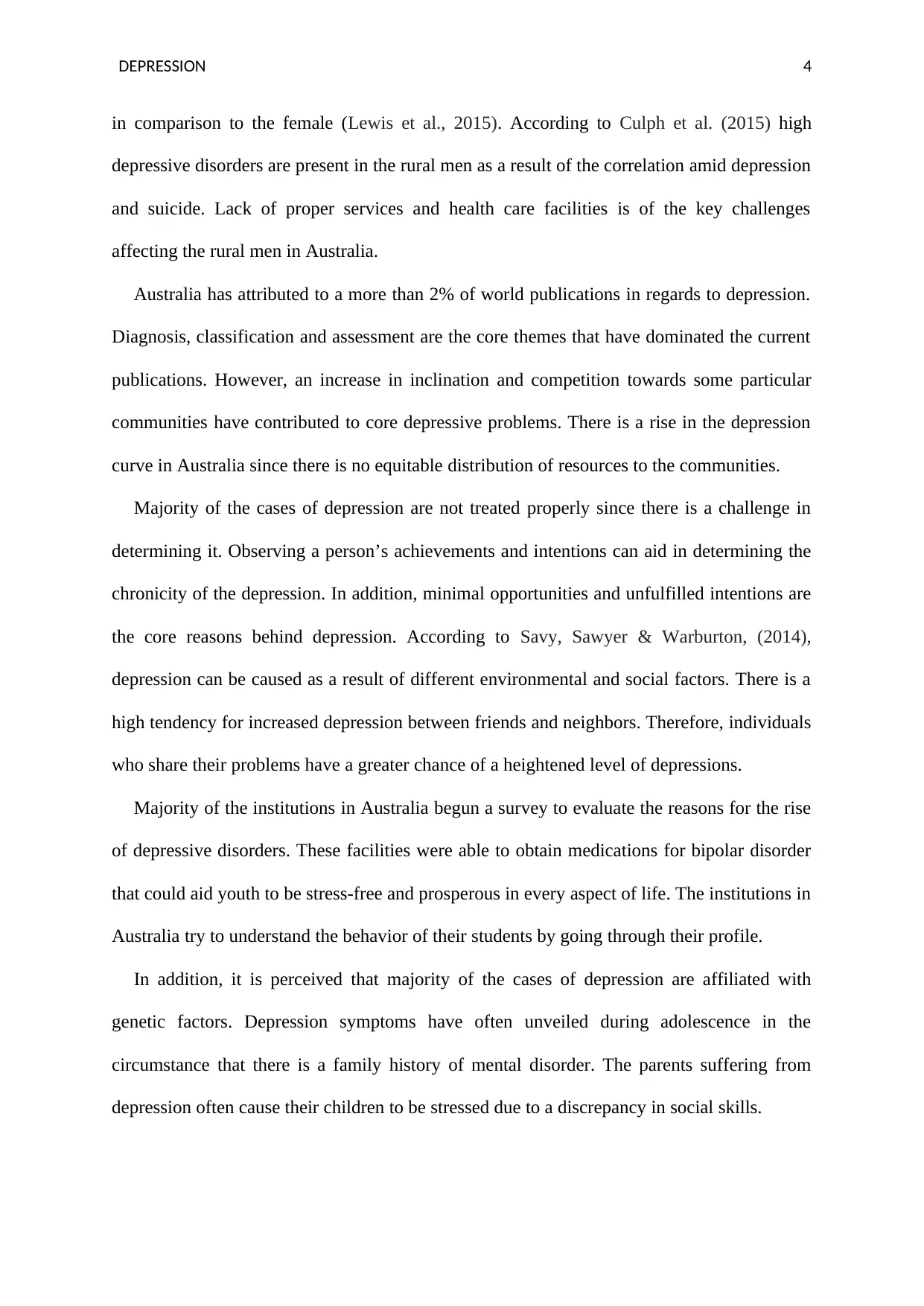
DEPRESSION 4
in comparison to the female (Lewis et al., 2015). According to Culph et al. (2015) high
depressive disorders are present in the rural men as a result of the correlation amid depression
and suicide. Lack of proper services and health care facilities is of the key challenges
affecting the rural men in Australia.
Australia has attributed to a more than 2% of world publications in regards to depression.
Diagnosis, classification and assessment are the core themes that have dominated the current
publications. However, an increase in inclination and competition towards some particular
communities have contributed to core depressive problems. There is a rise in the depression
curve in Australia since there is no equitable distribution of resources to the communities.
Majority of the cases of depression are not treated properly since there is a challenge in
determining it. Observing a person’s achievements and intentions can aid in determining the
chronicity of the depression. In addition, minimal opportunities and unfulfilled intentions are
the core reasons behind depression. According to Savy, Sawyer & Warburton, (2014),
depression can be caused as a result of different environmental and social factors. There is a
high tendency for increased depression between friends and neighbors. Therefore, individuals
who share their problems have a greater chance of a heightened level of depressions.
Majority of the institutions in Australia begun a survey to evaluate the reasons for the rise
of depressive disorders. These facilities were able to obtain medications for bipolar disorder
that could aid youth to be stress-free and prosperous in every aspect of life. The institutions in
Australia try to understand the behavior of their students by going through their profile.
In addition, it is perceived that majority of the cases of depression are affiliated with
genetic factors. Depression symptoms have often unveiled during adolescence in the
circumstance that there is a family history of mental disorder. The parents suffering from
depression often cause their children to be stressed due to a discrepancy in social skills.
in comparison to the female (Lewis et al., 2015). According to Culph et al. (2015) high
depressive disorders are present in the rural men as a result of the correlation amid depression
and suicide. Lack of proper services and health care facilities is of the key challenges
affecting the rural men in Australia.
Australia has attributed to a more than 2% of world publications in regards to depression.
Diagnosis, classification and assessment are the core themes that have dominated the current
publications. However, an increase in inclination and competition towards some particular
communities have contributed to core depressive problems. There is a rise in the depression
curve in Australia since there is no equitable distribution of resources to the communities.
Majority of the cases of depression are not treated properly since there is a challenge in
determining it. Observing a person’s achievements and intentions can aid in determining the
chronicity of the depression. In addition, minimal opportunities and unfulfilled intentions are
the core reasons behind depression. According to Savy, Sawyer & Warburton, (2014),
depression can be caused as a result of different environmental and social factors. There is a
high tendency for increased depression between friends and neighbors. Therefore, individuals
who share their problems have a greater chance of a heightened level of depressions.
Majority of the institutions in Australia begun a survey to evaluate the reasons for the rise
of depressive disorders. These facilities were able to obtain medications for bipolar disorder
that could aid youth to be stress-free and prosperous in every aspect of life. The institutions in
Australia try to understand the behavior of their students by going through their profile.
In addition, it is perceived that majority of the cases of depression are affiliated with
genetic factors. Depression symptoms have often unveiled during adolescence in the
circumstance that there is a family history of mental disorder. The parents suffering from
depression often cause their children to be stressed due to a discrepancy in social skills.
Paraphrase This Document
Need a fresh take? Get an instant paraphrase of this document with our AI Paraphraser
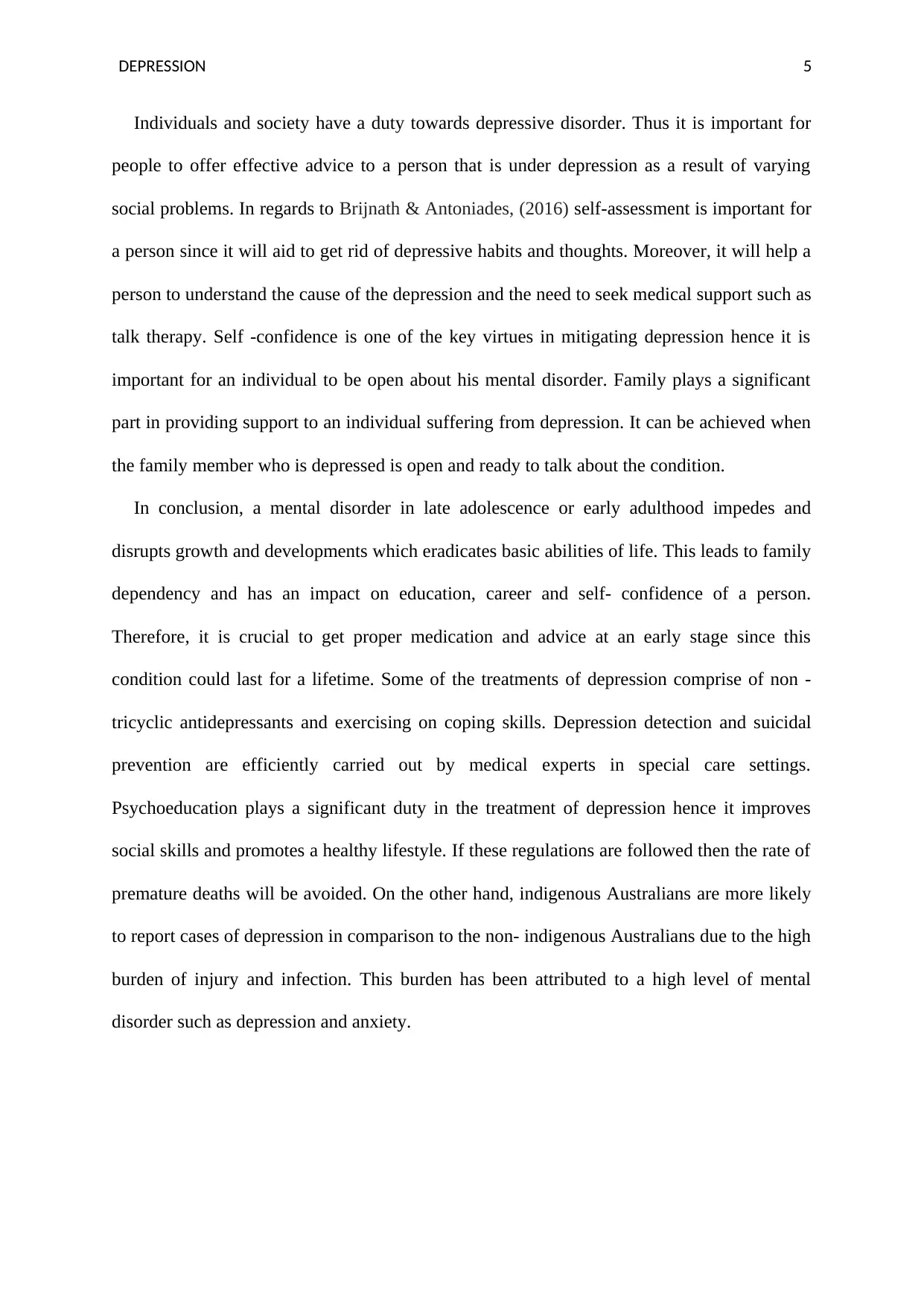
DEPRESSION 5
Individuals and society have a duty towards depressive disorder. Thus it is important for
people to offer effective advice to a person that is under depression as a result of varying
social problems. In regards to Brijnath & Antoniades, (2016) self-assessment is important for
a person since it will aid to get rid of depressive habits and thoughts. Moreover, it will help a
person to understand the cause of the depression and the need to seek medical support such as
talk therapy. Self -confidence is one of the key virtues in mitigating depression hence it is
important for an individual to be open about his mental disorder. Family plays a significant
part in providing support to an individual suffering from depression. It can be achieved when
the family member who is depressed is open and ready to talk about the condition.
In conclusion, a mental disorder in late adolescence or early adulthood impedes and
disrupts growth and developments which eradicates basic abilities of life. This leads to family
dependency and has an impact on education, career and self- confidence of a person.
Therefore, it is crucial to get proper medication and advice at an early stage since this
condition could last for a lifetime. Some of the treatments of depression comprise of non -
tricyclic antidepressants and exercising on coping skills. Depression detection and suicidal
prevention are efficiently carried out by medical experts in special care settings.
Psychoeducation plays a significant duty in the treatment of depression hence it improves
social skills and promotes a healthy lifestyle. If these regulations are followed then the rate of
premature deaths will be avoided. On the other hand, indigenous Australians are more likely
to report cases of depression in comparison to the non- indigenous Australians due to the high
burden of injury and infection. This burden has been attributed to a high level of mental
disorder such as depression and anxiety.
Individuals and society have a duty towards depressive disorder. Thus it is important for
people to offer effective advice to a person that is under depression as a result of varying
social problems. In regards to Brijnath & Antoniades, (2016) self-assessment is important for
a person since it will aid to get rid of depressive habits and thoughts. Moreover, it will help a
person to understand the cause of the depression and the need to seek medical support such as
talk therapy. Self -confidence is one of the key virtues in mitigating depression hence it is
important for an individual to be open about his mental disorder. Family plays a significant
part in providing support to an individual suffering from depression. It can be achieved when
the family member who is depressed is open and ready to talk about the condition.
In conclusion, a mental disorder in late adolescence or early adulthood impedes and
disrupts growth and developments which eradicates basic abilities of life. This leads to family
dependency and has an impact on education, career and self- confidence of a person.
Therefore, it is crucial to get proper medication and advice at an early stage since this
condition could last for a lifetime. Some of the treatments of depression comprise of non -
tricyclic antidepressants and exercising on coping skills. Depression detection and suicidal
prevention are efficiently carried out by medical experts in special care settings.
Psychoeducation plays a significant duty in the treatment of depression hence it improves
social skills and promotes a healthy lifestyle. If these regulations are followed then the rate of
premature deaths will be avoided. On the other hand, indigenous Australians are more likely
to report cases of depression in comparison to the non- indigenous Australians due to the high
burden of injury and infection. This burden has been attributed to a high level of mental
disorder such as depression and anxiety.
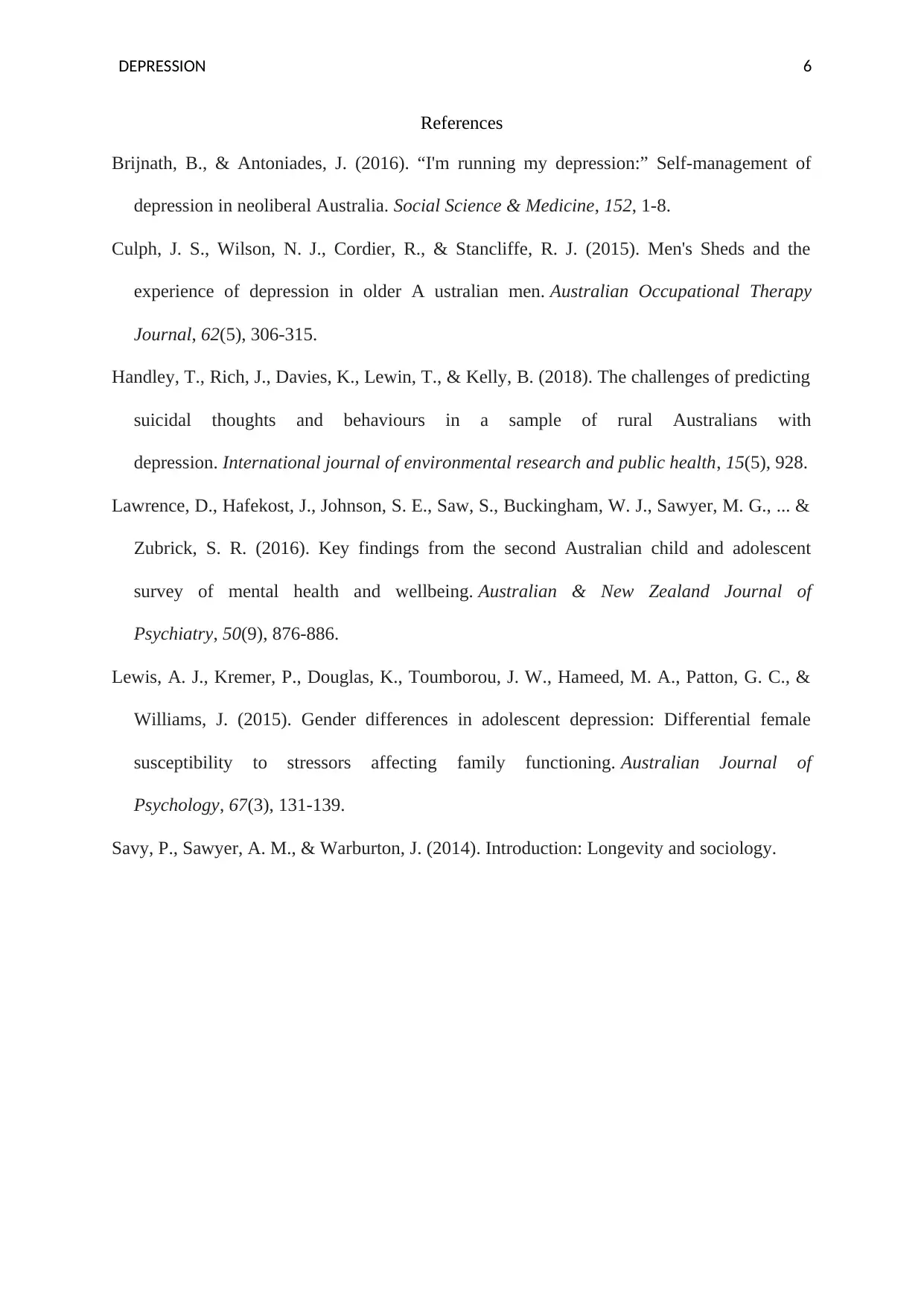
DEPRESSION 6
References
Brijnath, B., & Antoniades, J. (2016). “I'm running my depression:” Self-management of
depression in neoliberal Australia. Social Science & Medicine, 152, 1-8.
Culph, J. S., Wilson, N. J., Cordier, R., & Stancliffe, R. J. (2015). Men's Sheds and the
experience of depression in older A ustralian men. Australian Occupational Therapy
Journal, 62(5), 306-315.
Handley, T., Rich, J., Davies, K., Lewin, T., & Kelly, B. (2018). The challenges of predicting
suicidal thoughts and behaviours in a sample of rural Australians with
depression. International journal of environmental research and public health, 15(5), 928.
Lawrence, D., Hafekost, J., Johnson, S. E., Saw, S., Buckingham, W. J., Sawyer, M. G., ... &
Zubrick, S. R. (2016). Key findings from the second Australian child and adolescent
survey of mental health and wellbeing. Australian & New Zealand Journal of
Psychiatry, 50(9), 876-886.
Lewis, A. J., Kremer, P., Douglas, K., Toumborou, J. W., Hameed, M. A., Patton, G. C., &
Williams, J. (2015). Gender differences in adolescent depression: Differential female
susceptibility to stressors affecting family functioning. Australian Journal of
Psychology, 67(3), 131-139.
Savy, P., Sawyer, A. M., & Warburton, J. (2014). Introduction: Longevity and sociology.
References
Brijnath, B., & Antoniades, J. (2016). “I'm running my depression:” Self-management of
depression in neoliberal Australia. Social Science & Medicine, 152, 1-8.
Culph, J. S., Wilson, N. J., Cordier, R., & Stancliffe, R. J. (2015). Men's Sheds and the
experience of depression in older A ustralian men. Australian Occupational Therapy
Journal, 62(5), 306-315.
Handley, T., Rich, J., Davies, K., Lewin, T., & Kelly, B. (2018). The challenges of predicting
suicidal thoughts and behaviours in a sample of rural Australians with
depression. International journal of environmental research and public health, 15(5), 928.
Lawrence, D., Hafekost, J., Johnson, S. E., Saw, S., Buckingham, W. J., Sawyer, M. G., ... &
Zubrick, S. R. (2016). Key findings from the second Australian child and adolescent
survey of mental health and wellbeing. Australian & New Zealand Journal of
Psychiatry, 50(9), 876-886.
Lewis, A. J., Kremer, P., Douglas, K., Toumborou, J. W., Hameed, M. A., Patton, G. C., &
Williams, J. (2015). Gender differences in adolescent depression: Differential female
susceptibility to stressors affecting family functioning. Australian Journal of
Psychology, 67(3), 131-139.
Savy, P., Sawyer, A. M., & Warburton, J. (2014). Introduction: Longevity and sociology.
⊘ This is a preview!⊘
Do you want full access?
Subscribe today to unlock all pages.

Trusted by 1+ million students worldwide
1 out of 6
Related Documents
Your All-in-One AI-Powered Toolkit for Academic Success.
+13062052269
info@desklib.com
Available 24*7 on WhatsApp / Email
![[object Object]](/_next/static/media/star-bottom.7253800d.svg)
Unlock your academic potential
Copyright © 2020–2025 A2Z Services. All Rights Reserved. Developed and managed by ZUCOL.





